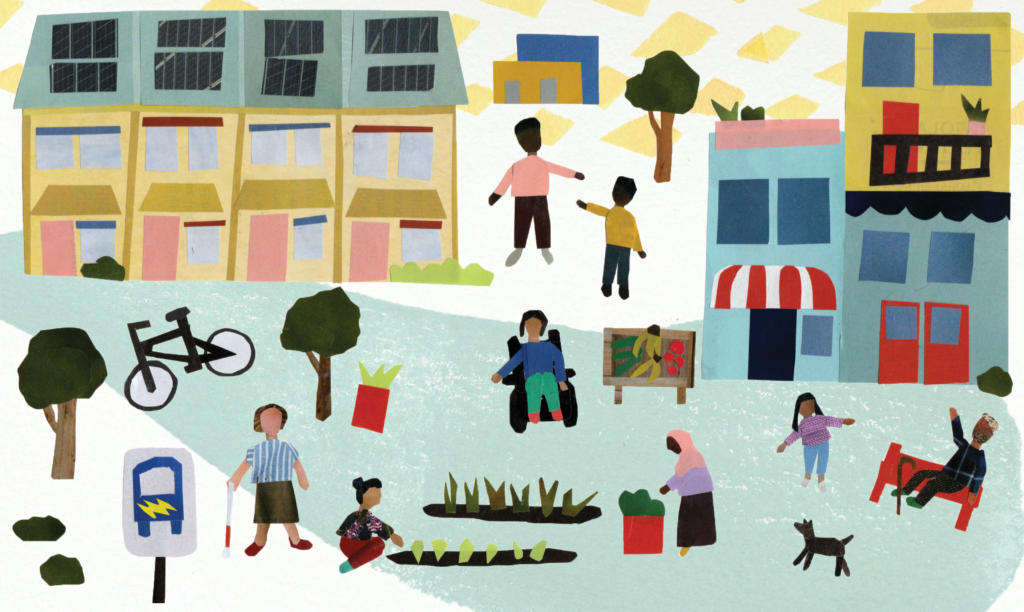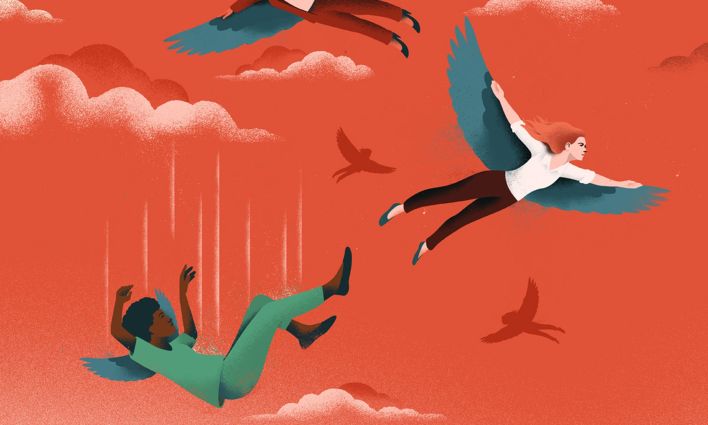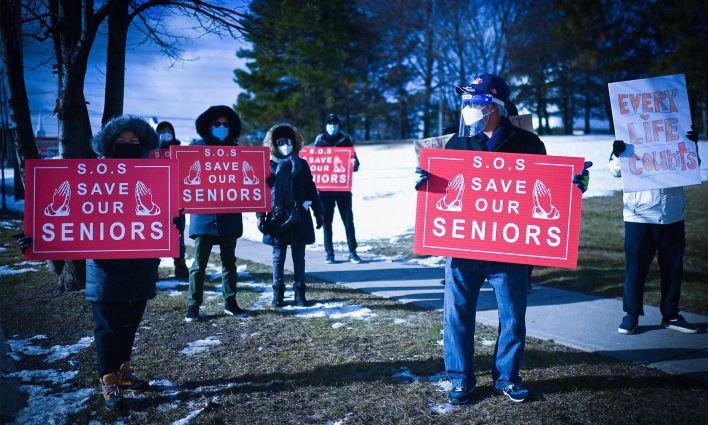Since the first COVID-19 lockdown sent many people home, a sense of locality has been building throughout communities as people became reacquainted with nearby parks, shops and neighbours, leaving large city centres, malls, and office buildings empty. But, what about the people who have sheltered in place without green spaces and grocery stores nearby?
This resurfacing sense of locality has sparked a new interest in the concept of the 15-minute city, an urban design that reshapes how we live. Developed by Carlos Moreno, a scientific director and professor specializing in intelligent control of complex systems at the Sorbonne, the model prioritizes a higher quality of life and sustainability by ensuring everyday needs are reached within 15-minutes of walking or biking. Moreno believes that cities will not return to their old “normal” post-pandemic and this is a great opportunity to reorganize how we live to become more sustainable and more accessible. Many Canadian municipalities seem to agree.
Cities across Canada including Edmonton, Victoria, and Ottawa are engaging with some version of a 15-minute model in their new official plans for city development. Though, to truly improve the quality of life for all residents, the design of 15-minute cities must include an equity analysis. Without built-in intersectionality accounting for how socioeconomic disparity between races, genders, mobilities, and classes manifests geographically, the 15-minute city model will entrench pre-existing inequalities and further stratify neighbourhoods along class lines.
Anne Hidalgo, the Mayor of Paris who used the 15-minute city as the core of her successful 2020 re-election campaign, says the concept is “a city of proximities—not only between structures but people”. Hidalgo’s hope is to use the 15-minute model to bring people together. However, this is easier said than done in Paris, an infamously segregated city and home to the banlieue neighbourhoods which have concentrated Paris’ most marginalized communities in the North Seine-Saint-Denis region. This disparity was laid bare by COVID-19, which left affluent quartiers virtually untouched while it ripped through the banlieues. “We are locked down in our inequality,” the Seine-Saint-Denis MP Alexis Corbière tells the Guardian. “The virus has just amplified the problems the banlieue has had for a long time. It has revealed how wide and deep the social fracture really is.” Introducing a 15-minute city model requires more than thinking about integrating new services into communities; it means addressing the multiple dimensions of race and class and how they currently interact with one another to keep marginalized communities pushed to the edges. This requires reexamining affordable housing allotments, zoning bylaws, and what spaces are dedicated to organizing to build community in order to live better as we live together, to remodel an inclusive social fabric.
Though, to truly improve the quality of life for all residents, the design of 15-minute cities must include an equity analysis.
How Affordable Housing and Zoning Laws Ensures 15-Minute Cities are Diverse, Inclusive, and Accessible.
Given the history of socioeconomic stratification by zoning, the BBC’s Peter Yeung reports many community advocates caution the 15-minute city will worsen social divides between people, increasing the inequalities between poorer and richer neighbourhoods. These fears are valid and it’s important cities who embrace this model ensure its use is wielded in a way that it becomes a tool of equalization, rather than entrenching inequality. To do so, it’s important to balance the quality and number of facilities and amenities in each neighbourhood to serve diverse populations equitably. Flavio Coppola, C40 Cities’ programme manager for urban planning argues that the neighbourhoods who need the most investment should be redeveloped first, ensuring they are not left with lower quality of resources.
Elisa Pieri, a sociology professor at Manchester University believes if 15-minute cities do not find this balance, marginalized neighbourhoods can end up with fewer resources, including scarcer and lower-quality medical professionals and schools. The result, “could bring about further discrimination and inequality and territorial stigmatization”.
Zoning bylaws are a critical tool in the fight to build vibrant, equitable communities. The bylaws that uphold affordable housing units in residential developments, for example, can ensure the quality of facilities are spread throughout cities, rather than concentrating them in higher socioeconomic neighbourhoods. Vienna has implemented a municipal housing zoning law committed to create affordable housing. The city’s initiative acts as a positive example and builds on its history of prioritizing mixed housing availability, with 62% of residents already living in public housing. This commitment has contributed to Vienna being ranked as the city with the highest quality of living worldwide on Mercer’s Quality of Living Ranking for ten years in a row. In 2015, the city’s new municipal housing construction programme was launched with the goal of developing 4,000 new housing units. In 2018, Vienna passed a new law requiring all new buildings of 5,000 square meters or more to use at least two-thirds of space for affordable housing.
Elisa Pieri, a sociology professor at Manchester University believes if 15-minute cities do not find this balance, marginalized neighbourhoods can end up with fewer resources, including scarcer and lower-quality medical professionals and schools. The result, “could bring about further discrimination and inequality and territorial stigmatization”.
In Canada, Montreal’s new 20-20-20 development bylaw, aims to meet community housing needs by including social, affordable, and family housing in new residential projects. Under the bylaw, developments greater than 450 square meters— approximately five dwellings or more—are required to dedicate 20% of space to each social, affordable and family housing. The new measure will create an estimated 600 social housing units and 500 family housing units per year, dispersed throughout the city. To maintain long-term availability of appropriate housing for all Montreal residents, the 20-20-20 ensures that a variety of units are built in all neighbourhoods:
affordable units whose rent or purchase price will be 10% or 20% (depending on their location) below market value;
social housing units whose construction is subsidized by social and community housing programs administered by the Québec government;
Family housing that includes at least three bedrooms and has additional living space that is adequate for a family. Adequate area is set at 86 m2 and 96 m2, depending on the sector of the city the housing is being built in.
Magda Popeanu, the executive committee vice-chair and Côte des Neiges councillor says the 20-20-20 rule was initially a strategy of inclusion, rather than an official bylaw. But as such, it wasn’t uniformly nor respected by the city’s existing zoning and bylaws. “Now it’s official,” Popeanu says, adding that through years of consulting with the public and affected communities, the bylaw represents the needs of the constituents.
Popeanu’s approach to consulting a variety of private and public stakeholders to create an inclusive development bylaw demonstrates the importance of organizing with your community, for them. Additionally, her efforts attest to the fact that neighbourhoods can be developed to be more inclusive, if community engagement is the starting point.
Cars Keep Marginalized Communities Out — Another Reason to Ditch Them.
Apart from the benefits of affordable housing and social inclusion, the 15-minute city also addresses a fundamental social issue in city life—transportation. Low-income residents living on the outer edges of cities are less likely to own a car, making daily commutes longer and more complicated to reach basic amenities. In North America, where outer-ring communities are not designed to be walkable or rely solely on public transit, households often feel that, where financially feasible, the decision to invest in a car is a foregone conclusion. Both scenarios: low-wage workers stuck on multi-transfer transit commutes and outer-ring communities relying on cars to reach services are not sustainable: both from an equity perspective and the latter from a climate perspective.
As the 15-minute city prioritizes walking and biking over driving, the design ensures that lower income demographics have greater proximity to access to basic amenities without needing access to a car. Steven Farber, a researcher from the University of Toronto Scarborough found that, at present, families who do not own a car take part in 0.6 activities a day in comparison to 1.1 activities a day for families who do own a vehicle.
Reclaiming urban space for walking and biking also frees up space that has been inefficiently relegated to vehicles. Moreno, reports 66% of public space in Paris is committed to cars despite, “individual cars only mov[ing] 17% of the population”. Between the space dedicated to cars and the number of people without them is room to reimagine how to better use this space to serve historically marginalized communities.
Steven Farber, a researcher from the University of Toronto Scarborough found that, at present, families who do not own a car take part in 0.6 activities a day in comparison to 1.1 activities a day for families who do own a vehicle.
This city reimagining is already underway in Amsterdam, where 10,000 parking spaces from the city centre have been removed and transformed into parks and public spaces, encouraging residents to spend more time in this green space, away from the built environment. This project contributes more broadly to Amsterdam’s half urban and half green neighbourhood plan, which offers a free space to residents to develop inclusive projects including gardens, clubs, fundraisers, and organized meetings.
Since Hidalgo took office in 2014, Paris’s neighbourhoods have seen a significant transformation. Roadways have been repurposed as greenspaces and paths for pedestrians and cyclists. Not only have emissions been reduced, but the changes are “tracing a path of community resilience” reports Coppola.
When necessities and housing are in a walkable and bikeable proximity to each other, repurposing roadways and parking lots becomes possible and allows more space for community engagement. The increase of available space around residential buildings allows community members to mix and interact, creating shared identity, building trust and social bonds.
Repurposing Office Spaces Could be the Next Horizon for Imagining 15-Minute Cities, Post-Pandemic.
At the time of writing, office vacancy in downtown Calgary had reached a new peak of 27%, and is expected to reach 30% within two years . Calgary is not alone as businesses across Canada reorganize and cancel their traditional office space leases during the COVID-19 pandemic. In this time of profound shifting in the ways that we live and work, there is space to repurpose to create more accessibility for a variety of shared services for a variety of people: particularly those who live in downtown centres.
When repurposing buildings to increase community engagement, it is important to ensure structures are converted with multi-functionality in mind. For example, a variety of public spaces and buildings can be used at different times of the day and week.
In Texas, a local church opens its doors as a coworking hub from Monday to Friday, outside of their hours of operation on the weekends. In Paris, school playgrounds provide residents access during the evenings, weekends, and summers as a space for recreation and community gardening. Similarly, office buildings, sport complexes, parks, gardens, and schools could serve residents a new purpose outside hours of operation. Allowing access to a variety of people to collaborate, organize, and engage, overcoming the challenge of accessibility many people face now.
Moving Forward in a 15-Minute City
Moreno believes humans are increasingly turning into urban species, though, urban environments remain not habitable for everyone. As cities swell in size, creating vibrant shared spaces will be vital to their—and our future.
If the model is used to centre the needs of residents, and address the inequities that are currently exacerbated by how our cities are structured, the 15-minute city has the potential to flourish as a tool to increase well-being and resiliency. Already in Paris, Moreno credits the use of this model with a rise in resident engagement, particularly around participatory budgeting, a process through which the residents of Paris vote on how to allocate 5% of municipal spending, totalling half of a billion Euros.
What we commonly see in our cities are neighbourhoods segregated by class, immigration status, and race. For a 15-minute city to properly serve all people, it needs to be undertaken for all people. Cities do not need new developments without adequate affordable and social housing or streets dedicated strictly for businesses. Both reproduce the segregation cities that we already experience, allowing exclusivity and inaccessibility to persist. It’s time to champion multi-functional zoning of neighbourhoods in the best interest of increasing inclusivity and accessibility, to reduce the distance between communities and services. As the world moves forward post-COVID-19, it is in all of our best interest to collaborate with city planners and each other to develop accessible and engaging communities to be part of the solution of social, geographic, and economic division.








